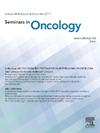tlr在胃肠道(GI)肿瘤中的不同功能:其诊断、预后和治疗价值综述
IF 2.5
3区 医学
Q2 ONCOLOGY
引用次数: 0
摘要
先天免疫信号与适应性免疫反应开始之间的关系是该理论的中心思想。toll样受体(Toll-like receptors, TLRs)作为PRRs家族中的一员,通过控制机体对损伤的炎症和组织修复反应,其在保护宿主免受感染和维持组织稳态方面的功能越来越受到人们的关注。微生物感染、损伤、炎症和组织愈合都与恶性肿瘤的发展有关,尤其是胃肠道(GI)癌症。最近,对TLR识别和结合及其配体的研究增加,大大提高了我们对各种TLR信号通路的认识,并为胃肠道恶性肿瘤的治疗提供了选择。在被病原体相关或损伤相关分子模式(DAMPs和PAMPs)激活后,TLRs触发NF-κB、MAPK和IRF等关键通路。NF-κB活化促进炎症、细胞存活和增殖,通常有助于肿瘤生长、转移和治疗抵抗。MAPK通路同样驱动不受控制的细胞生长和侵袭,而IRF通路调节干扰素的产生,产生抗肿瘤和肿瘤的作用。由此产生的肿瘤内的慢性炎症环境可以促进进展,但TLR激活也可以刺激有益的抗肿瘤免疫反应。然而,TLR表达在胃肠道肿瘤中的功能及其诊断、预后和治疗价值尚未完全阐明。了解TLR激活如何促进对胃肠道恶性肿瘤的抗癌免疫,可能会加速免疫治疗的发展,提高患者的生存率。本文章由计算机程序翻译,如有差异,请以英文原文为准。
Divergent functions of TLRs in gastrointestinal (GI) cancer: Overview of their diagnostic, prognostic and therapeutic value
The relationship between the innate immune signal and the start of the adaptive immune response is the central idea of this theory. By controlling the inflammatory and tissue-repair reactions to damage, the Toll-like receptors (TLRs), as a family of PRRs, have attracted increasing attention for its function in protecting the host against infection and preserving tissue homeostasis. Microbial infection, damage, inflammation, and tissue healing have all been linked to the development of malignancies, especially gastrointestinal (GI) cancers. Recently, increased studies on TLR recognition and binding, as well as their ligands, have significantly advanced our knowledge of the various TLR signaling pathways and offered therapy options for GI malignancies. Upon activation by pathogen-associated or damage-associated molecular patterns (DAMPs and PAMPs), TLRs trigger key pathways like NF-κB, MAPK, and IRF. NF-κB activation promotes inflammation, cell survival, and proliferation, often contributing to tumor growth, metastasis, and therapy resistance. MAPK pathways similarly drive uncontrolled cell growth and invasion, while IRF pathways modulate interferon production, yielding both anti-tumor and protumor effects. The resulting chronic inflammatory environment within tumors can foster progression, yet TLR activation can also stimulate beneficial anti-tumor immune responses. However, the functions of TLR expression in GI cancers and their diagnostic and prognostic along with therapeutic value have not yet entirely been elucidated. Understanding how TLR activation contributes to anti-cancer immunity against GI malignancies may hasten immunotherapy developments and increase patient survival.
求助全文
通过发布文献求助,成功后即可免费获取论文全文。
去求助
来源期刊

Seminars in oncology
医学-肿瘤学
CiteScore
6.60
自引率
0.00%
发文量
58
审稿时长
104 days
期刊介绍:
Seminars in Oncology brings you current, authoritative, and practical reviews of developments in the etiology, diagnosis and management of cancer. Each issue examines topics of clinical importance, with an emphasis on providing both the basic knowledge needed to better understand a topic as well as evidence-based opinions from leaders in the field. Seminars in Oncology also seeks to be a venue for sharing a diversity of opinions including those that might be considered "outside the box". We welcome a healthy and respectful exchange of opinions and urge you to approach us with your insights as well as suggestions of topics that you deem worthy of coverage. By helping the reader understand the basic biology and the therapy of cancer as they learn the nuances from experts, all in a journal that encourages the exchange of ideas we aim to help move the treatment of cancer forward.
 求助内容:
求助内容: 应助结果提醒方式:
应助结果提醒方式:


